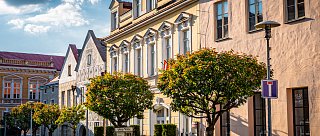Slavonice – A Town of Art and Craft Traditions
 Slavonice is located on the Moravian side of the South Bohemian Region and is the westernmost town on the historical territory of Moravia.
Slavonice is located on the Moravian side of the South Bohemian Region and is the westernmost town on the historical territory of Moravia.
The first written mention of Slavonice dates back to 1260. Originally it was a settlement, later a market village that belonged to the Lords of Hradec. In the 14th century, the settlement expanded to include two market squares: one to the west (today's Peace Square) and one to the east (Horní náměstí). Between the squares stands the parish church of the Assumption of the Virgin Mary with dominating the town tower. The church was built from the mid-14th century, but the tower was not built until 1503-1549.
The town experienced its greatest development in the 16th century. The most valuable monuments date from this period - the town houses with richly decorated facades, on which, in addition to scribal motifs, you can also find a large number of intricate figural sgraffiti. We can admire the vaulted arches (e.g. Nos. 461 and 480), the vaulted mausoleums (e.g. No. 479), the frescoed hall (No. 476) and the elaborate labyrinth of underground passages beneath it all. Another valuable monument is the Lutheran house of prayer from 1568 in the Upper Square (no. 517) with frescoes depicting scenes from the Apocalypse.
The medieval town flourished mainly thanks to the craftsmen's guilds, the most important of which was the guild of weavers. Their emblem is still carved at the entrance to the town tower, which the soukeneers had built in the town. You climb the 176 steps up to the tower to the tower keeper's flat, through which you go to the gallery. Here you have a beautiful view not only of the two Renaissance squares, but also of the landscape of Bohemian Canada.
After the death of Zachariah of Hradec (1589), a new nobility came here and with it the decline of the town. The Thirty Years' War resulted in the sacking of Protestant Slavonice. Most of the townspeople left the town in 1623 and the rest of the inhabitants were affected by the plague at the end of the 17th century. Other blows to the town were the relocation of the postal road and a great fire - both disasters came in the 1750s. The fire burned 44 houses and the town tower.
In the 19th century, the textile industry began to return to Slavonice, and in 1902 a new railway connected Slavonice with Telč. In the brief period of prosperity before World War I, the town hall was rebuilt, two new schools were built on the site of the manor house and salt warehouse, and other Renaissance houses were rebuilt. Part of the medieval walls, including the Austrian Gate, were also removed. Of the three original gates, only two have survived: the Jemnicka Gate (also known as the Znojemská Gate) and the Dačická Gate (also known as the Bolíkovská or Red Gate).
By the end of World War II, most of the inhabitants were of German nationality. After the war, the German population was displaced and Slavonice became part of the border zone. After the political situation calmed down at the turn of 1958-1959 they were excluded from this zone and in 1961 they were declared a municipal reserve. The town applied for the UNESCO World Heritage List and was awarded the title of Historic Town of the Year 2017, which recognises the care of its cultural and historical heritage.
Slavonice is not only a beautiful historic town, but also a picture of the turbulent history of the region. Perhaps its greatest asset is its frozen time - time that has preserved Slavonice as a beautiful Renaissance jewel.
Additional information
Families and personalities
- Leopold Österreicher (Estreicher, Esterreicher) - (1515-?) - Slavonice burgher and builder, participated in the construction of the most valuable buildings in Slavonice, worked, among others, on the castle in Telč and Jindřichův Hradec. His stone mark LO can be found, for example, on the top stone of the entrance portal of the cemetery chapel of St. Cross.
Our tip
Slavonice also offers a rich cultural life. Among the most popular events are the summer film and music festival Slavonice Fest, Slavonice Cultural Summer, Slavonice Triple Frontier Festival, and the 1938 Raid of the Trenches (a reconstruction of the battle encounter between the Czechoslovak Army and the Czechoslovak Army).
Don't forget to visit the underground tunnels and the town tower and see the Museum of Border Fortifications.
Do you know that...
...Slavonice is a town of artists and craftsmen? You will find sculpture studios and textile and ceramic workshops here and you can take away a handmade souvenir.
.... the historical centre and the surrounding nature have also appealed to filmmakers? Some of the more obscure films that have been filmed here include After the Stubble, Valérie and the Week of Wonders, The Wanderings of Jan Amos and the fairy tale The Tramps of Jakoubek the Waterboy.




